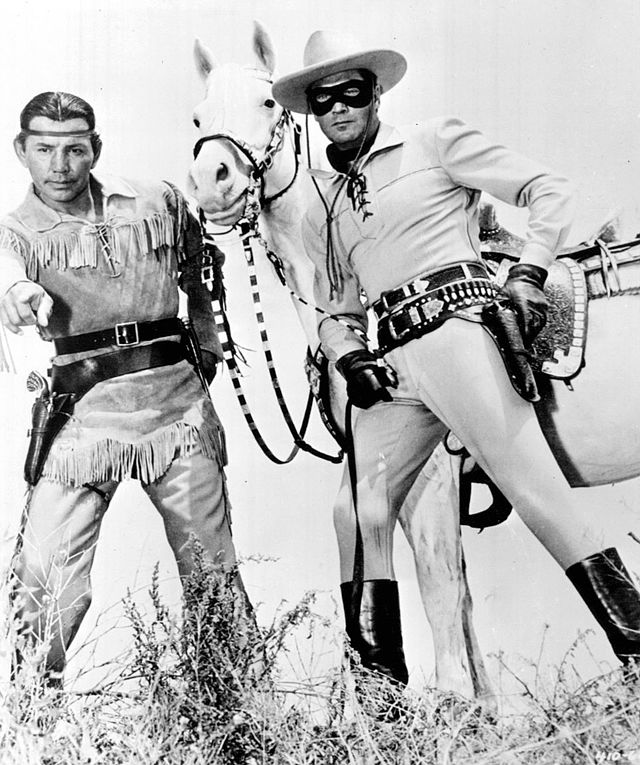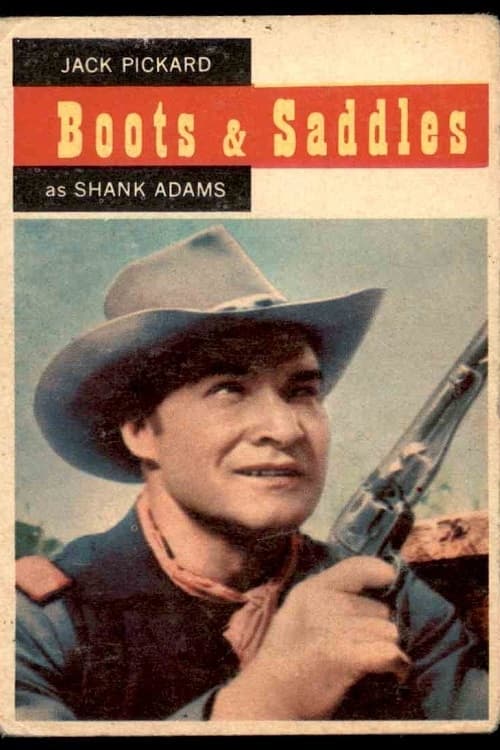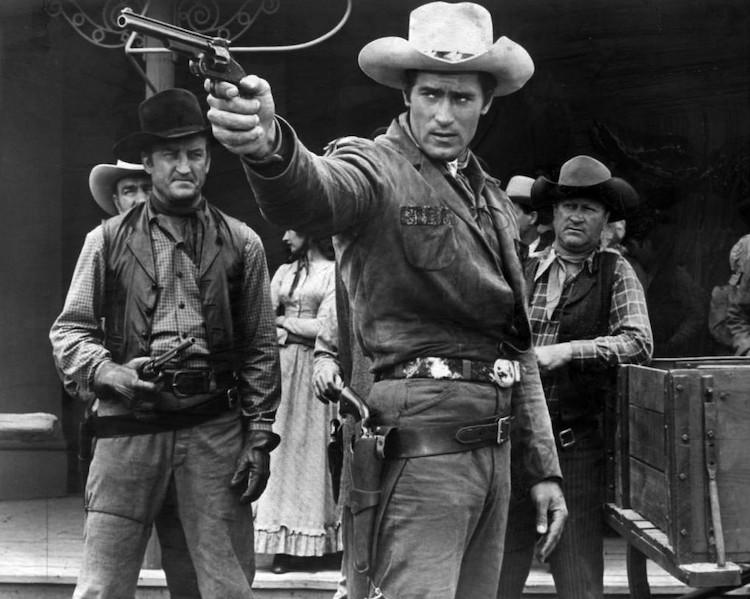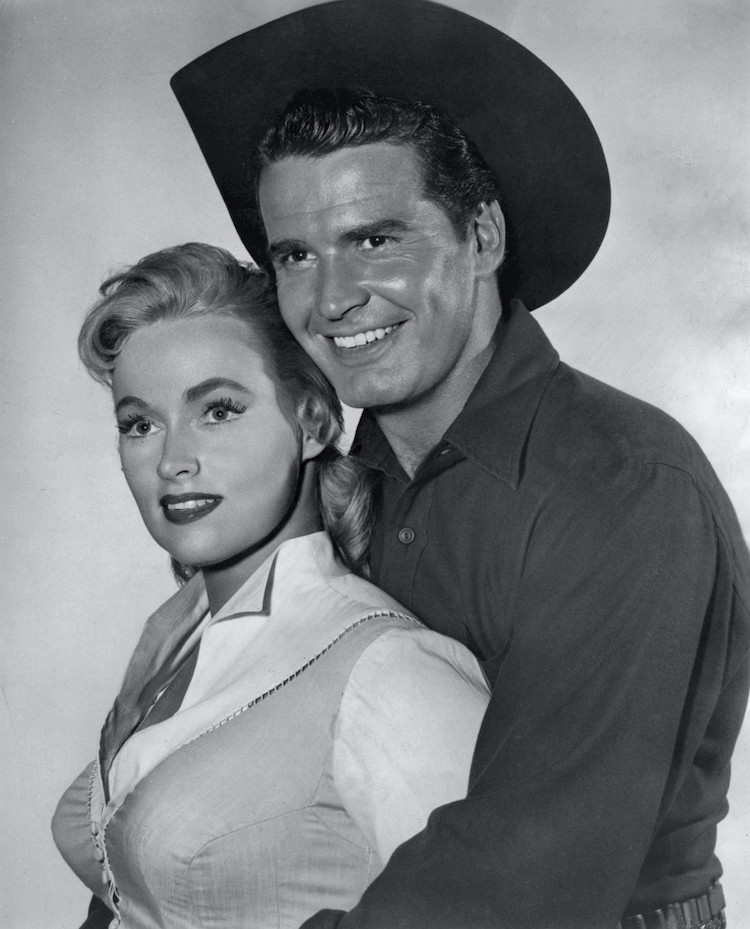A few years back I wrote an article on my favourite John Wayne films I saw as a snot-nosed kid. I thought it was time to revisit those halcyon days of childhood again but this time consider the TV Westerns I saw when I was young as well.
The shows in question are listed in order of when I saw them on British TV as opposed to when they first aired in America. For example “Cheyenne” debuted in 1955 on U.S. TV but I saw “Boots and Saddles”, which debuted in 1957 before “Cheyenne” aired on TV over here in the UK.
The Lone Ranger
We can recall it like it was yesterday, the first bars of the “William Tell Overture” playing over the opening credits of “The Lone Ranger” TV show, then the words no cowboy fan growing up in the late 1940s / 1950s worth their salt is ever going to forget; “A fiery horse with a speed of light, a cloud of dust and a hearty hi-yo Silver – the Lone Ranger.

Hi yo Silver away!” We’ll leave you masked LR fans to fill in the rest.
“The Lone Ranger” started out as a radio show in the early 1930s, eventually morphing into the full-blown TV show we baby boomers, all still knee-high to a grasshopper, loved so much, hitting the trail in 1949 and running for five seasons and a total of just over two-hundred episodes until 1957.
As you are all well aware the main role was played by Clayton Moore with Jay Silverheels, a genuine Mohawk, taking on the role of faithful companion Tonto.
Due to a rather vague contractual dispute Moore was replaced halfway through the run of the show by John Hart for a total of fifty-two episodes, Moore then returning to the role for the remaining seasons.
Each half hour program would feature the masked man and his noble Native American companion doing battle with the bad guys, with numerous episodes featuring familiar faces such as Hank Worden, DeForest Kelley, Ray Teal, James Arness, Lee Van Cleef, Martha Hyer, Harry Carey Jr. and Glenn Strange, Strange playing the villain in the very first episode of the show.
Moore and Silverheels also hit the big screen in a couple of movies, “The Lone Ranger”, released in 1956 and “The Lone Ranger and the Lost City of Gold”, released in 1958.
Later on, in 1981, most people steered well clear of “The Legend of the Lone Ranger” as well as the most recent version featuring Johnny Depp as Tonto, although Arnie Hammer makes a halfway decent effort as the masked man.
Nevertheless, Clayton Moore and Jay Silverheels are the real deal. Accept no substitute. “Hi yo Silver away!”
Boots and Saddles
“Boots and Saddles” debuted on American TV in September 1957, lasting for only one season and a total of thirty-nine episodes. The series was filmed in black and white with each episode running for approximately twenty-five minutes.

Due to the short run of “Boots and Saddles”, it’s not a TV Western that’s generally remembered in the company of classics such as “Cheyenne” or “Maverick”.
That’s a shame because in general it was aimed at more of an adult audience as opposed to young children.
It featured a number of regular characters including Jack (John) Pickard as Captain Shank Adams, Patrick McVey as Lieutenant Wesley Hayes, Gardner McKay as Lieutenant Dan Kelly with John Alderson playing Sergeant Bullock.
It was their job to maintain peace on the Arizona frontier in the 1880s whenever the local Apache tribes threatened unrest. The show was set in the fictional Fort Lowell, the set of which had been built previously for the 1953 Western movie “Pony Express” starring Charlton Heston.
Guest stars on the show included Claude Akins, DeForest Kelley and Strother Martin. One of the named writers was Gene Roddenberry who of course went on to create “Star Trek” ten years later.
Although it has yet to be released officially on DVD there are a number of clips from the program available on YouTube as well as two full episodes, “Quiet Day At Fort Lowell” and “The Obsession”.
On a personal level, I have a dim memory of seeing an episode, possibly called “The Lost Patrol”, when I was a youngster which featured the character of Sergeant Bullock trying to get back to the fort after he and his patrol have been ambushed by the Apache.
He carries on his back one of the men wounded in the skirmish and eventually makes it to Fort Lowell in one piece only to realise that his companion had been dead all the time. Grim stuff.
Cheyenne
Debuting on the ABC channel in September 1955, “Cheyenne” was not only the first Warner Bros TV Western shows to grace the small screen but was also the first hour long (including advert breaks) series made for television.
Six-foot six-inch tall Clint Walker played the character of wanderer Cheyenne Bodie.

Having been raised by the Cheyenne tribe after the death of his parents, Bodie is depicted as a loner constantly on the move from one town to the next, skilled as a tracker and occasional army scout but mainly proficient in punching out the lights of the bad guys at the first hint of trouble, something which generally occurred at least once in each episode.
During a number of the fight sequences Mr. Walker was usually required to shed his upper clothing in order to display his beefcake physique, which must have set hearts fluttering amongst his many female fans.
“Cheyenne” attracted some great acting talent throughout its run, with James Garner and L.Q. Jones (as short-lived side-kick Smitty) appearing in the very first episode.
Other episodes featured guest spots from the likes of Dennis Hopper, Angie Dickinson, Slim Pickens, Claude Akins and Ellen Burstyn.
Whilst the series doesn’t appear to have attracted big name or soon-to-be-famous directors the writing credits include the likes of Alan LeMay, Richard Matheson and Dan Reisner along with uncredited contributions from Jules Furthman and William Faulkner.
The calibre of the writing talent goes some way to justifying the reputation of the show when it came to the quality of the scripts.
Clint took a hiatus from the series in 1957 when he and Warner Bros engaged in a contractual dispute over the actor earning income outside of the show, in turn giving Ty Hardin the opportunity to appear as Cheyenne’s country cousin Bronco Laine during Walker’s absence.
As well as introducing “Bronco” to TV, Warner’s also decided to screen the pilot episode of “The Dakotas” at the end of season six of “Cheyenne” in 1962, the show then debuting in its own right in January of the following year.
Walker actually returned again to the part of Bodie quite a few years after the final episode of the original series hit the airwaves. First off was a guest appearance in “The Gambler Returns”, the fourth in the five TV movies in which singer Kenny Rogers played Bradie Hawks, a character based upon his hit single “The Gambler”.
The TV movie also featured a few of Clint’s TV Western contemporaries including Chuck Connors, Hugh O’Brien and Gene Barry. David Carradine, as Caine from the “Kung Fu” TV show, put in an appearance as well, Walker going on to reprise the character of Cheyenne one final time in a “Kung Fu” episode entitled “The Gunfighters”.
“Cheyenne” is fondly remembered for its wistful theme tune composed by William Lava with lyrics by Stan Jones, who also provided the words to the song played over the opening credits to “The Searchers”.
Maverick
One of the most popular of the Warner Bros. TV cowboy shows, “Maverick” debuted on the ABC network in September 1957. Initially featuring the humorous adventures of card-sharp Bret Maverick, as played by James Garner.
Jack Kelly then turned up in the eighth episode of season one as Bart, brother of Bret. From then on Garner and Kelly would appear in alternate episodes, occasionally teaming up every now and then as required by the storyline.
Garner left the show after three seasons and over fifty episodes to pursue a career on the big screen, going on to appear in box-office hits such as “The Great Escape”, “Move Over Darling” and “Duel at Diablo”. The actor returned to the role that made him famous in the spin-off series “Brett Maverick” in the early 1980s.

Roy Huggins, one of the creators of the show, went on to co-create the character of private investigator Jim Rockford, reuniting Huggins and James Garner in the successful and highly popular TV detective series “The Rockford Files”.
After Garner departed from “Maverick” another family member was required and so in walked Roger Moore as cousin Beau. Just prior to Moore then leaving the series after appearing in fourteen episodes in season four, yet another family member surfaced, this time brother Brent Maverick, played by Robert Colbert.
When season five appeared Brent was nowhere to be seen and Jack Kelly then carried the show on his own until it ended in 1962 after five seasons and one-hundred and twenty-four episodes.
Many of those episodes featured quite a few famous guest stars such as Clint Eastwood, Buddy Ebsen and Efrem Zimbalist Jr., as well as soon-to-be famous actor Robert Redford and actress Louie Fletcher. One episode also featured cross-over appearances of characters from other Warner cowboy TV shows of the time including Clint “Cheyenne” Walker and Ty “Bronco” Hardin.
James Garner and the role of Bret Maverick became so intertwined over time that it was inevitable he would appear in the big screen version of “Maverick” in 1994. With Mel Gibson in the title role, Garner played a character by the name of Zane Cooper. At the end of the film (spoiler alert) it is revealed that Cooper is Bret Maverick’s father.
As for the TV series itself, one thing that most of the Warner Bros Western shows had in common were the memorable theme tunes, and “Maverick” had one of the best. Check out the following link if you don’t believe me. Sheer bliss.
Bronco
As already mentioned, the character of Bronco Layne first appeared in “Cheyenne”, Ty Hardin taking the lead in a number of episodes as the country cousin of Cheyenne Bodie when Clint Walker and Warner Bros were involved in a contract dispute.
Once the situation had been resolved Walker returned to the show and Hardin, who in the meantime had attracted quite a lot of female fan attention, was rewarded with his own spinoff series, running for four seasons from 1958 to 1962 and totalling sixty-eight episodes approximately one-hour in length (including commercial breaks).
Having fought for the Confederacy in the Civil War, Layne traverses the plains whilst encountering real-life characters such as Jesse James, Billy the Kid and John Wesley Harding. Directors of note associated with certain episodes of the show included Andre DeToth, Robert Altman and Richard C. Sarafian.
The guest stars are also quite interesting, Bronco making the acquaintance of actors such as Robert Vaughan, Mary Tyler Moore, James Coburn, Adam West, James Best and a very young Jack Nicholson, to name but a few.
For a while the show alternated every other week with another Warner Bros TV Western, “Sugarfoot”, starring Will Hutchins, both Hardin and Hutchins guest starring in each other’s show as their respective characters.
Ruggedly handsome to say the least, Ty Hardin became a huge star, the show enjoying immense popularity throughout its four-year run, especially in the UK.
Whilst light-hearted and fun to watch equally for both kids and grown-ups the show would occasionally take on a more serious tone. One of the most memorable episodes that come to mind features Bronco joining a group of men gathered together to track down a wanted man.
Riding with them is a Native American who, to Bronco’s consternation, appears not to be able to sleep, choosing instead to sit and stare at everyone instead. It eventually comes to light that the man is actually asleep even though his eyes aren’t closed, on account of someone having sliced off his eyelids at some point.
I think I had nightmares for weeks after that.
As with other Western series of the time “Bronco” had a very catchy theme tune, penned by Mack David and Jay Livingstone, one that still lingers as an earworm for baby boomers of a certain age. Enjoy:
For more TV Westerns of the 1950s and 1960s go to part 2.
